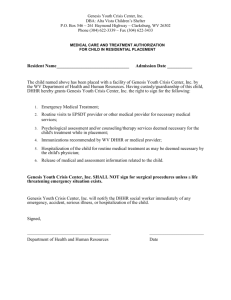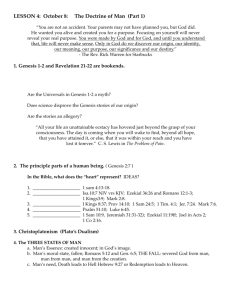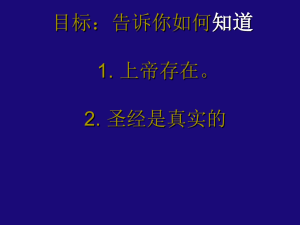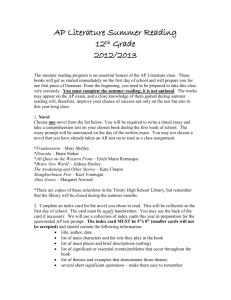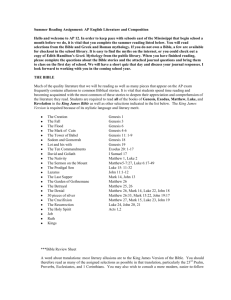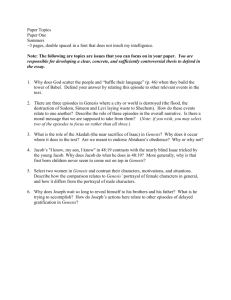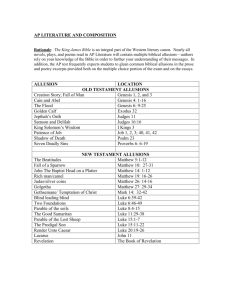AP English Literature Summer Assignment
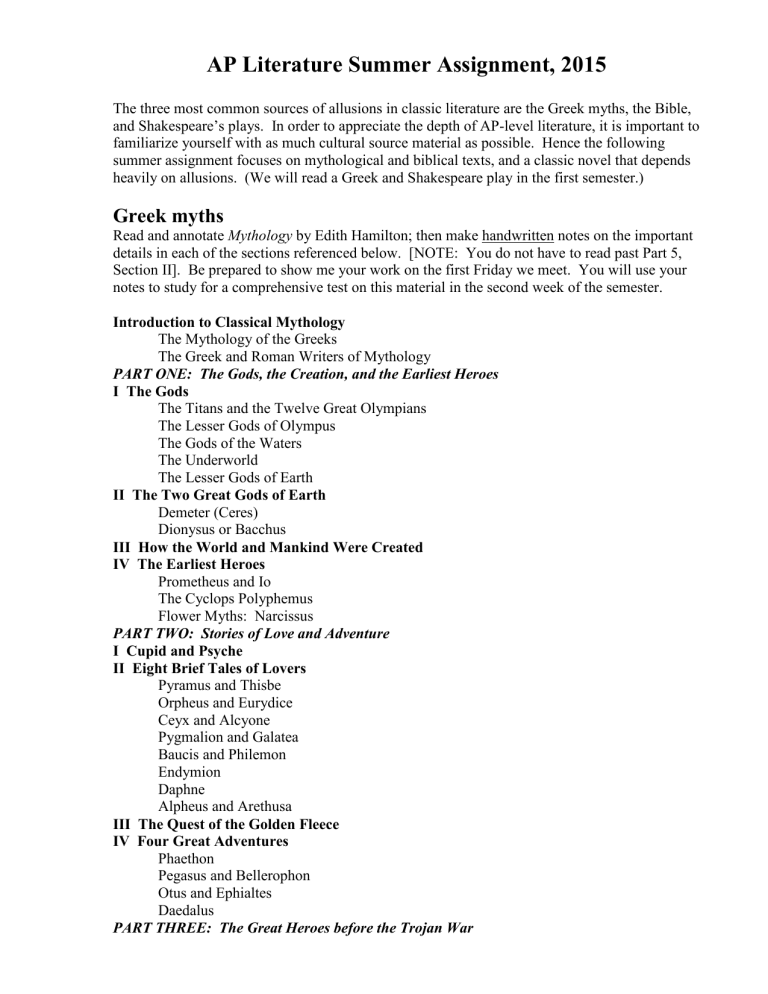
AP Literature Summer Assignment, 2015
The three most common sources of allusions in classic literature are the Greek myths, the Bible, and Shakespeare’s plays. In order to appreciate the depth of AP-level literature, it is important to familiarize yourself with as much cultural source material as possible. Hence the following summer assignment focuses on mythological and biblical texts, and a classic novel that depends heavily on allusions. (We will read a Greek and Shakespeare play in the first semester.)
Greek myths
Read and annotate Mythology by Edith Hamilton; then make handwritten notes on the important details in each of the sections referenced below. [NOTE: You do not have to read past Part 5,
Section II]. Be prepared to show me your work on the first Friday we meet. You will use your notes to study for a comprehensive test on this material in the second week of the semester.
Introduction to Classical Mythology
The Mythology of the Greeks
The Greek and Roman Writers of Mythology
PART ONE: The Gods, the Creation, and the Earliest Heroes
I The Gods
The Titans and the Twelve Great Olympians
The Lesser Gods of Olympus
The Gods of the Waters
The Underworld
The Lesser Gods of Earth
II The Two Great Gods of Earth
Demeter (Ceres)
Dionysus or Bacchus
III How the World and Mankind Were Created
IV The Earliest Heroes
Prometheus and Io
The Cyclops Polyphemus
Flower Myths: Narcissus
PART TWO: Stories of Love and Adventure
I Cupid and Psyche
II Eight Brief Tales of Lovers
Pyramus and Thisbe
Orpheus and Eurydice
Ceyx and Alcyone
Pygmalion and Galatea
Baucis and Philemon
Endymion
Daphne
Alpheus and Arethusa
III The Quest of the Golden Fleece
IV Four Great Adventures
Phaethon
Pegasus and Bellerophon
Otus and Ephialtes
Daedalus
PART THREE: The Great Heroes before the Trojan War
I Perseus
II Theseus
III Hercules
IV Atalanta
PART FOUR: The Heroes of the Trojan War
I The Trojan War
The Judgment of Paris
The Trojan War
II The Fall of Troy
III The Adventures of Odysseus
IV The Adventures of Aneneas
From Troy to Italy
The Descent into the Lower World
The War in Italy
PART FIVE: The Great Families of Mythology
I The House of Atreus
Tantalus and Niobe
Agamemnon and His Children
Iphigenia among the Taurians
II The Royal House of Thebes
Cadmus and His Children
Oedipus
Antigone
The Seven against Thebes
Biblical stories
Respected literary critic Northrop Frye said in The Great Code: The Bible and Literature that the
Bible provides "an imaginative framework — a mythological universe — within which Western literature had operated down to the eighteenth century and is to a large extent still operating."
During the course of the semester, we will read literature that alludes to details from the biblical texts below. Read and annotate, then make handwritten notes on the following texts from the
King James or New Revised Standard translation of the Bible (you can find both on-line). I will collect these notes the first Friday of class. Expect assessments on this material.
Genesis
Creation/The Garden of Eden (Genesis 1-4)
-Adam and Eve
-Cain and Abel
Noah and the flood (Genesis 6-9)
Tower of Babel (Genesis 11:1-9)
Abraham and Sarah (Genesis 11-23)
-Hagar and Ishmael (Genesis 16)
-Sodom, Lot and Lot’s Wife (Genesis 18-19)
-Abraham and Isaac (Genesis 21-22)
Isaac and Rebekah (Genesis 24)
Jacob and Esau (Genesis 25-28)
Jacob, Leah and Rachel (Genesis 29-30)
Jacob Reconciles with Esau (Genesis 32-33)
Joseph, his Brothers and his Coat (Genesis 37-50)
Exodus
Moses’ birth, adoption, revelation at the Burning Bush (Chapters 1-7)
Ten plagues, Passover (Chapters 7-13)
Exodus, Red Sea, Pharaoh’s army destroyed (Chapters 14-18)
Moses receives the law, ten commandments (Chapters 19-24) --YOU MAY STOP HERE--
Gospel of Matthew
Jesus’ nativity and baptism (Matthew 1-3)
Jesus’ temptation, disciples, beatitudes, Sermon on the Mount (Matthew 4-6)
The Golden Rule, healings (Matthew 7-9)
Calling the twelve apostles, persecution, parables (Matthew 10-13)
Miracles, transfiguration, teachings (Matthew 14-20)
Entry to Jerusalem, questioning, arrest, trial, crucifixion, the empty tomb (Matthew 21-28)
Gospel of Luke
Parable of the Good Samaritan (Luke 10:25-37)
Parable of the Prodigal Son (Luke 15:11-32)
Classic Literature
The Scarlet Letter by American author Nathaniel Hawthorne challenges the institutions of church and state with its powerful message of nature-based morality, individual freedom and self-worth, which were mainstays of the American Romantic movement. SKIP THE LONG PREFACE and, starting with Chapter 1, read the novel carefully, making notes as you go that will help you address the following prompt in essay form:
Nathaniel Hawthorne’s The Scarlet Letter makes use of Biblical allusions to deepen its treatment of the moral superiority of Hester Prynne. Write an essay that explains how familiarity with the parable of the ‘pearl of great price’ from the book of Matthew helps the reader understand the overall meaning of Hawthorne’s novel. Highlight your thesis and claims in yellow. Staple your notes to the back of the essay.
Grading
Each of these three summer assignments is worth 50 points, graded on an AP scale of 1-9. Late work will drop a grade for each period it is not turned in.
8-9 = A = 45-50 points: work shows great effort and thoroughness
6-7 = B = 40-44 points: work shows effort, but inconsistent thoroughness
5 = C = 35-39 points: work is minimal, but complete
3-4 = D = 30-34 points: work is incomplete
1-2 = F = 25-29 points: some work is turned in
0 assignment not turned in
Honor Code
The successful study of advanced literature involves close reading, original thinking, and critical scholarship, none of which can be achieved by depending on inferior resources (e.g. Sparknotes ,
Shmoop) , or by plagiarizing the work of others. As a student in AP Literature, you will be asked to sign an honor code pledging that: 1.) you will read the original texts and think independently, and 2.) you will not substitute someone else’s summaries, notes, analyses, or interpretations for your own work. In return, I pledge to make the reading assignments reasonable and support your understanding of the texts with classroom discussion.

